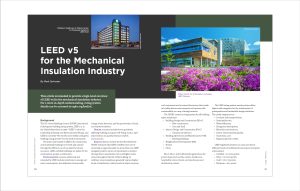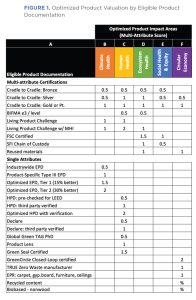LEED v5 for the Mechanical Insulation Industry
This article is intended to provide a high-level overview of LEED v5 for the mechanical insulation industry. For a more in-depth understanding, rating system details can be accessed at usgbc.org/leed/v5.
Background
The U.S. Green Building Council (USGBC) introduced its first green building rating system, LEED 1.0, in the United States back in 1998. “LEED” is short for Leadership in Energy and Environmental Design, and LEED is currently “the world’s most widely used green building rating system”1 for the built environment.
The intent and benefit of LEED is for commercial and residential buildings to be built and operate through the efficient use of our planet’s natural resources. LEED-certified buildings are better for the environment, people, and business.
Environmental concerns addressed and rewarded by LEED include reductions in energy and water consumption, the utilization of renewable energy, waste diversion, and the preservation of land and sensitive habitats.
Human concerns include factors positively affecting building occupant well-being, such as optimized indoor air quality, thermal comfort, and acoustics.
Business factors include the fact that while the USGBC estimates that LEED-certified total cost of ownership is approximately 2% more than non-LEED designed projects, return on investment is realized through lower operational costs and higher resale values throughout the life of the building. In addition, tenant employees generally express higher levels of satisfaction, which results in lower turnover; and consumers tend to reward businesses that reside in healthy indoor environments and operate with sustainability as a way of doing business.
The USGBC created a rating system for all building types and phases:
- Building Design and Construction (BD+C)
New construction
Core and shell - Interior Design and Construction (ID+C)
Commercial interiors - Building Operations and Maintenance (O+M)
Existing buildings - Neighborhood Development (ND)
- Homes
- Cities
BD+C, ID+C, and O+M include applications for project types such as data centers, health care, hospitality, retail, schools, and warehouses and distribution centers.
The LEED rating system awards points within eight credit categories for the achievement of prerequisites and sustainable design attributes.
The credit categories are:
- Location and transportation,
- Sustainable sites,
- Water efficiency,
- Energy and atmosphere,
- Materials and resources,
- Indoor environmental quality,
- Innovation, and
- Regional priority credits.
LEED-registered projects can earn one of four different levels of certification based upon total point achievement.
- Certified = 40 to 49 points
- Silver = 50 to 59 points
- Gold = 60 to 79 points
- Platinum = 80+ points
Since 1998, the LEED rating system has continually evolved to the more recent LEED v4 (2013) and LEED 4.1 (2020). LEED v5 is currently in a public comment stage and is scheduled to be launched in Q1 2025. Future updates will occur every 5 years, with v6 to be launched in 2030.
Since v4.1 registrations will be accepted through the end of 2025, the construction industry will experience typical overlap between v4.1 and v5 beyond 2025.
The approach of LEED v5 is holistic and intended to drive a low-carbon future that is equitable and resilient, and that promotes the wise utilization of all resources. New impact areas are prioritized and weighted for credit point distribution as follows:
- Decarbonization (50%),
- Quality of life (25%), and
- Ecological conservation and restoration (25%).
The number of rating system scorecards has been reduced to four.
- Two for building design and construction (BD+C):
New construction and major renovations
Core and shell development - One for interior design and construction (ID+C): commercial interiors
- One for operations and maintenance (O+M): existing buildings
Additionally, the credits required to achieve the LEED Platinum rating have been increased.
Mechanical Insulation and the New Impact Areas
The new impact areas share a common focus with the use of mechanical insulation.
- Decarbonization: By helping to reduce energy use, mechanical insulation can prevent CO2 emissions—which is at the root of decarbonization. Further, insulation itself is a low embodied carbon material.
- Quality of Life: Properly insulated buildings enhance occupant well-being by reducing noise, maintaining optimum temperature, protecting people from spread of fire, etc. In industrial use, insulation also enhances personnel safety. Mechanical insulation can attenuate unwanted noise, assist with delivering thermal comfort, ensure life safety in the event of fire, and deliver personnel protection.
- Ecological conservation and restoration: As means to achieve energy efficiency, mechanical insulation prevents unnecessary use of fossil fuels. When building mechanical systems (piping, equipment, and ductwork) are properly insulated and maintained, energy consumption and greenhouse gases are reduced through the reduction of heat loss/gain when compared to bare or under-insulated system components.
Material and Resources Credits
Below are the applicable credits under the Materials and Resources (MR) credit category. Relevant impact areas appear in parentheses.
MR Credit: Optimized Building Products (1 to 5 points, Quality of Life, Ecological Conservation and Restoration)
The content in this section is taken from the USGBC website,2 only lightly edited and reformatted here for ease of reading.
Intent: To encourage the use of products and materials for which life-cycle information is available and that have environmentally, economically, and socially preferable impacts. To reward project teams for selecting products from manufacturers who have optimized their products across multiple impact areas.
Requirements: Select nonstructural building products that achieve multiple optimization criteria across five impact areas: climate health, human health, ecosystem health, social health and equity, and circular economy.
Figure 1 illustrates how eligible multi-attribute product documentation and certifications are valued in LEED. Column A lists the eligible types of product documentation, while columns B through F indicate how each product documentation or certification is valued across the optimized product impact areas. The values in columns B through F represent a “multi-attribute score” for the product, which will be multiplied by the number of products, cost, area, or volume, depending on the credit option and pathway chosen in Option 1 or Option 2.
A single product may only claim one multi-attribute score per impact area (up to the maximum score achieved for the product from columns B through F). Some products may have one single attribute, in which case the multi-attribute score is worth the total for that documentation type. Other times, a single product may have more than one certification or documentation, in which case the maximum values from the columns B through F are added together to obtain a single multi-attribute score (multiplier) for the product, up to a maximum of score of 5.0. Note that double counting of impact areas is not allowed.
For example, if a product has a Product-Specific Type III Environmental Product Declaration (EPD) and a Cradle to Cradle Silver certification, that product will receive a multi-attribute score of 4.0, as follows:
- Column A: Climate Health – 1.0 score (maximum of 1.0 from Product-Specific Type III EPD and 0.5 from Cradle to Cradle Silver),
- Column B: Human Health – 1.0 score from Cradle to Cradle Silver,
- Column C: Ecosystem Health – 1.0 score from Cradle to Cradle Silver,
- Column D: Social Health and Equity – 0.5 score from Cradle to Cradle Silver, and
- Column E: Circular Economy – 0.5 score from Cradle to Cradle Silver.
Next, there are two options to consider:
- Option 1: Product Disclosure and Optimization from All Product Categories (1 to 2 Points)
- Option 2: Optimized Product Categories (1 to 6 Points)
Option 1: Product Disclosure and Optimization from All Product Categories (1 to 2 Points)
This option involves selecting and installing nonstructural materials that are optimized across multiple impact areas according to Figure 1. Products can come from any category, as long as they are permanently installed. Products with eligible documentation are valued for their multi-attribute score, up to a maximum score of 5 per unique product. (See Equation 1 for an example of how to calculate multipliers for a unique product.)
Points are awarded according to Table 1.
Equation 1. Determining Number of Optimized Products
A single product valuation = 1 product X “
multi-attribute” score
Example:
- A permanently installed product has a multi-attribute score (sum of columns B through F from Figure 1) of 3.5 across multiple impact areas.
- The product is worth 3.5 “products” for the purposes of Option 1 credit calculation.
Option 2: Optimized Product Categories (1 to 6 Points)
Select and install nonstructural materials that are optimized across multiple impact areas according to Figure 1. Create a bill of materials and categorize products by the following product categories:
- Insulation–measured by cost or area
- Adhesives and sealants–measured by cost, volume, or area
- Paints and coatings–measured by cost, volume, or area
Earn up to 5 points for selecting optimized products in multiple product categories.
- Any single product category that includes more than 100% of optimized products earns 1 point.
- Any single product category that includes more than 200% of optimized products is eligible for 1 exemplary performance point.
The amount of optimized products per product category is calculated by multiplying each individual product’s value (cost, area, volume, or unit) times the product’s multi-attribute score from Figure 1 (columns B through F). Each individual product’s multi-attribute score in the product category is then added together to determine the total optimized product value for that product category.
To determine if the product category includes enough optimized products to earn points, compare the total optimized product value for the category to the total value (without multipliers) for all products in the product category, including those products that do not have sustainability attributes.
1. MR Credit: Low-Emitting Materials (Quality of Life)
According to the USGBC, there also are notable changes to this credit category, from v4.1 to v5, where thermal insulation and installation products have often contributed to LEED registered projects.
- Credit Category:
v4.1 – Indoor Environmental Quality (EQ)
v5 – Materials & Resources (MR) - Points:
v4.1–1 to 3 points
v5–2 points - Insulation:
v4.1–At least 75% to all insulation products must meet the VOC emissions evaluation; HVAC and plumbing piping insulation excluded.v5–All insulation products must meet the VOC emissions evaluation; HVAC and plumbing piping insulation excluded; project teams may elect to include HVAC insulation at their discretion. - Adhesives & Sealants (all interior adhesives and sealants wet applied on site):
v4.1–At least 75% of all adhesives and sealants, by volume or surface area,
must meet the VOC emissions evaluation, and 100% meet the VOC content evaluation.v5–All adhesives and sealants, by volume or cost, must meet the VOC emissions and VOC content evaluation. A VOC content budget may be used. - Paints and Coatings (all interior paints and coatings applied on site):
v4.1–At least 75% of all paints and coatings, by volume or surface area, must meet the VOC emissions evaluation, and 100% meet the VOC content evaluation.v5–All adhesives and sealants, by volume, cost, or surface area, must meet the VOC emissions and VOC content evaluation. A VOC content budget may be used. Foamed in-place and sprayed insulation must be included in Insulation category.3
Carbon
LEED BD+C: New Construction v5 – Carbon Assessment looks at a 25-year projected carbon assessment for the project. The intent is to understand and reduce long-term direct and indirect carbon emissions including on-site combustion, grid-supplied electricity, refrigerants, and embodied carbon. The assessment needs to utilize the data from the following prerequisites:
- EA Prerequisite: Operational Carbon Projection and Decarbonization Plan
- EA Prerequisite: Fundamental Refrigerant Management
- MR Prerequisite: Assess Embodied Carbon
- Optional: LT Credit: Transportation Demand Management
Summary
Mechanical insulation will continue to contribute to the Energy and Atmosphere (EA) credit category through enhanced energy efficiency.
Potential credit contributions in the Indoor Environmental Quality category include Thermal Environment and Sound Environment.
Depending on the project location, mechanical insulation may also contribute to the Project Priorities and Innovation (IN) credit category.
The challenge for industry manufacturers will be to offer LEED project design teams product solutions that are optimized across v5 impact areas: climate health, human health, ecosystem health, social health and equity, and the circular economy.
References
1. https://www.usgbc.org/leed
2. https://www.usgbc.org/credits/new-construction/v5-public-comment-1-39?return=%2Fcredits%2FNew%20Construction%2Fv5%20%20Public%20Comment%201%2FSustainable%20sites
3. https://www.usgbc.org/credits/new-construction/v5-public-comment-1-38?return=/credits/New%20Construction/v5%20-%20Public%20Comment%201



